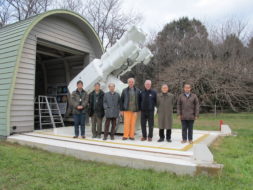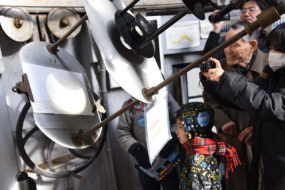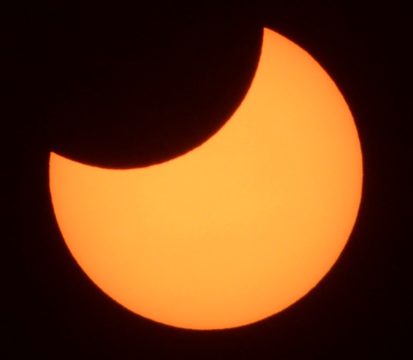A deep partial solar eclipse was witnessed by many early on the cold morning of January 6th in northeast Asia and the north Pacific.

Jay Pasachoff
A partial eclipse, as the name suggests, is when the Moon’s disk doesn’t entirely cover the solar disk, making it look as if the Sun has had a bite taken out of it. A deep partial eclipse is when the bite is big, almost covering the solar disk, and turning the Sun into a dazzling crescent. Partial solar eclipses are slightly more common than total (and annular) eclipses since the Moon and the Sun don’t have to be perfectly aligned.
As Chair of the International Astronomical Union’s Working Group on Eclipses, Jay Pasachoff arranges outreach events for solar eclipses and solar astronomy wherever he goes. For the January 6th eclipse, he traveled to Tokyo where he visited the National Astronomical Observatory of Japan (NAOJ). Jay was hosted by solar astronomers Yoichiro Hanaoka and Eijiro Hiei at NAOJ’s Mitaka Campus, and he and fellow observers witnessed the eclipse from the grounds of the Solar Flare Telescope. The Telescope Dome, the oldest observational facility on the campus, is used for public outreach, especially for solar observations, and so after eclipse maximum Jay and his hosts joined throngs of visitors, including children, to see a projected image of the eclipse through the Telescope Dome’s 20-cm refractor.

Jay Pasachoff
Elsewhere, Xavier Jubier traveled to Oymyakonsky District, a good thousand kilometers east of Yakutsk in the mountains. The valley of Oymyakon is known as the “Pole of Cold” for its notoriously low temperatures – it vies for this honor with another town in Yakutia, Verkhoyansk. When Xavier and his father visited, they chose a hilltop with an unobstructed view of the horizon overlooking Tomtor where the temperature was around –55°C (–67°F). Xavier speculates that they might be the only ones to have witnessed an eclipse in such extreme conditions, at least outside of Antarctica and, more importantly, with no heated shelter nearby. He goes on to describe it as brutal, being outdoors for three hours, and having to take extra precautions regarding equipment that can become brittle at those temperatures. Despite the conditions, Xavier reported complete success at 60% obscuration!

Jay Pasachoff
Jay Pasachoff’s recorded temperature of 6°C (43°F) feels positively balmy in comparison. In Tokyo, they had clouds for the first half hour of the eclipse, conditions cleared up for the middle hour and forty minutes, and then it clouded over again, with some visibility through the clouds and haze for the last half hour.
Among other observers who witnessed the eclipse were Paul Maley who reported success after the first 30 minutes from a park 6 miles from Inchon, South Korea; Jörg Schoppmeyer who saw the whole eclipse from Harbin, China; and Daniel Fischer who, monitoring feeds while in Germany, reported images from Russia, China (Beijing), and Japan. If you saw the eclipse, we'd love to hear from you in the comments below.
When’s the next eclipse? Is it a lunar eclipse or a solar eclipse? Will you have to travel to see it? Find everything you need to know right here.
Just remember: The Sun is bright, very bright. Don’t ever look directly at the Sun – even during a partial eclipse – for you will damage your eyes, possibly permanently. To view an partial solar eclipse, use eclipse glasses, or project the image onto a piece of a paper using either a pinhole or a pair of binoculars or even a telescope. Better yet, hook with your local astronomy club – they may have a solar scope fitted with the appropriate filters.
 0
0
Comments
You must be logged in to post a comment.